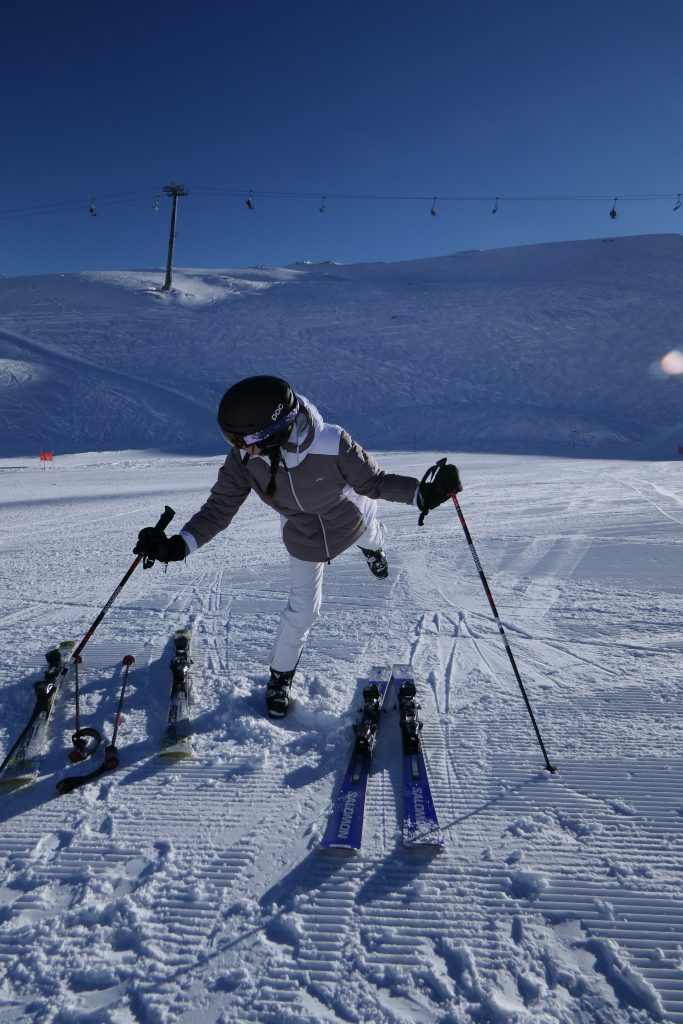Unfortunately Rachel was unwell today – but I suggest that Anna and Rob try to teach the contents of todays session to Rachel when she returns to the snow. (Teaching is often the best way to learn!)
- Pivot
- Body Management (Hip Angulation) (combating rotation)
- Combining Dynamics with Pivot
- Combining Snowplough with Dynamics
Pivot (Skis sliding Sideways)
Pivoting is derived from the skis sliding sideways and can be developed from side slipping (It’s a braking form of turning). With a “pure pivot” as an exercise there is no forward travelling of the ski across the hill. Support for the centre of mass is now provided by support from a downhill pole plant. This is the real reason why we have ski poles! There is a full dedicated explanation of pivoting at the following link: “PIVOT“
Body Management (Hip Angulation)
Take a look at the two Olympic champion skiers in the photograph below.
Killy’s image from the 1960s has his chest facing downhill whereas Noel’s image from 2022 has his chest facing forward. What Killy is doing destroys your lower back and is probably why he never went on skis again after he stopped racing.

Protecting the Spine
- Hold the front of the pelvis up – aiming for “neutral pelvis”
- During the turn pull the outer hip backwards so that the ski doesn’t pull it in front of your ribs
- Look for a stretch between the ribs and hip joint
- Look for a reflex contraction of the lower abdominals – the postural reflex
- Keep the shoulders/chest following the skis (to some degree)
- Always “counter turn” the pelvis more than the chest/shoulders (It’s only the pelvis that should “face downhill”)
- Pulling the hip backwards also prevents both hip rotation and full upper body rotation
Source of Hip Angulation
The upper body needs to tilt forward over one hip joint – then rotate around it. This is in addition to pulling back the outside hip etc.
The body shape produced alters the location of the centre of mass enabling pressure on the ski fronts and also greater agility both into and out of turns – and pole planting if the skis are swinging laterally.
The hip angulation also provides flexion of the hip joint that gives absorption of shocks. Increased angulation also increases the edge angle of the skis to the snow and may alter the turn radius and grip.
Angulation when upright and pivoting has another function – when ANTICIPATING the next turn it is used to get the Centre of Mass out of the existing turn (by tilting the torso forward at the hip ) and letting the Centre of Mass move over the skis to plant the ski pole downhill for a strong, clear and definite support.

When the entire body inclines into the turn with hip angulation present this below is what it looks like.

Combining Dynamics with Pivot
- Dynamics depends on forward motion of the skis and lateral falling/pushing of the centre of mass
- Pivot depends on lateral motion of the skis – but always with the centre of mass being driven inward (toward the turn centre)
- The two can be combined – when there is both forward and lateral motion – making overall control of trajectory and speed totally under control of the skier
- In all cases there must be active adductor muscle use – and the feet must be “everted” i.e. turned outward inside the ski boots – diverging sightly (skating stance)
- The essential element to take from combining pivot and dynamics is to execute the turn transition from the uphill edge of the uphill ski – noting that the ski enters the new turn more easily than when on its inside edge and this also prevents stemming (and body rotation)
Combining Snowplough with Dynamics
Dynamics is explained in terms of the mechanics of accelerations. (F=mA Newton’s 2nd Law). In skiing this means you move your centre of mass (either falling or with a push) in the direction you want to turn. You do not transfer your weight to the outside ski as is incorrectly taught in ski schools.
In the Snowplough using dynamics requires the adductors of both legs to be engaged and now the “deflection” is carried out by moving the Centre of Mass (CoM) across the skis in the direction of turning. The displacement of the CoM affects the geometry of both skis with respect to the slope (one goes flatter and the other more on edge) and that’s where the deflection comes from.
On steeper terrain the downhill ski (inside ski of the turn) takes the weight of the body and is used as a brake – pivoting slowly into the turn – until half way through the weight shifts by itself to the outside ski which is now able to take over the continued braking effect.

